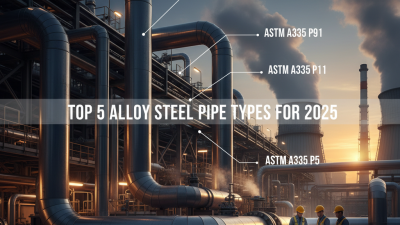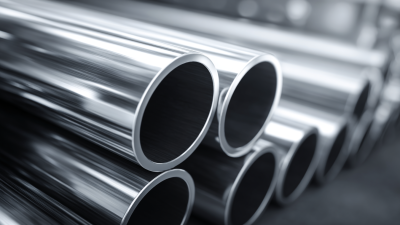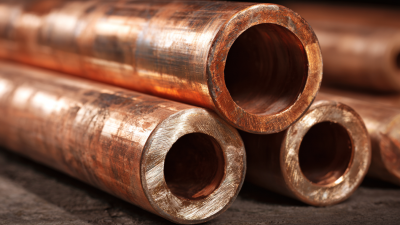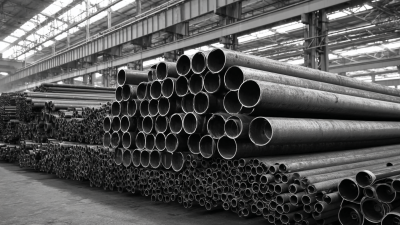Top 5 Alloy Steel Pipe Types for 2025: A Comprehensive Buying Guide
In the rapidly evolving world of construction and manufacturing, the importance of utilizing the right materials cannot be overstated.
Alloy Steel Pipes, known for their versatility and strength, play a vital role in a variety of applications, from oil and gas to infrastructure development.
As we approach 2025, understanding the different types of Alloy Steel Pipes available on the market becomes increasingly essential for industry professionals and buyers alike.
This comprehensive buying guide aims to shed light on the top five alloy steel pipe types, highlighting their specific characteristics, advantages, and applications.

Choosing the right Alloy Steel Pipe type is crucial for ensuring durability and efficiency in your projects. Each variation offers unique properties that cater to specific needs, such as resistance to high temperatures, corrosion, or extreme pressure.
By familiarizing yourself with the distinct types outlined in this guide, you can make informed decisions that contribute to the success of your operations.
Whether you are in the early phases of planning a major project or looking to optimize existing infrastructure, understanding these alloys will empower you with the knowledge to select the best materials for your requirements.
Key Characteristics of Alloy Steel Pipes Essential for 2025
When considering alloy steel pipes for your projects in 2025, understanding their key characteristics is essential. Alloy steel pipes are known for their superior strength and durability due to the incorporation of elements like chromium, nickel, and molybdenum. These additions enhance their resistance to corrosion, which is particularly beneficial in industries that face harsh environmental conditions. Moreover, they exhibit excellent mechanical properties, enabling them to withstand high pressures and temperatures.
Tips: When selecting alloy steel pipes, it’s crucial to evaluate the specific requirements of your application. Consider factors such as operating temperatures, pressure ratings, and corrosion resistance. This will help you choose the right type for your needs, ensuring both safety and efficiency.
Another vital characteristic of alloy steel pipes is their versatility. These pipes can be manufactured in various sizes and specifications, making them suitable for a wide array of applications, from oil and gas to construction and automotive industries. The adaptability of alloy steel pipes, combined with their strength, makes them a preferred choice for many engineers and contractors.
Tips: Always consult with a supplier or manufacturer to obtain detailed material data sheets. This ensures that you get pipes that meet industry standards and specifications tailored to your particular project demands.
Popular Alloy Steel Pipe Grades and Their Applications
Alloy steel pipes are crucial components in various industries, each grade offering unique properties suited for specific applications. Among the popular grades, ASTM A53 is notable for its versatility in structural frameworks and low-pressure pipeline systems. Its carbon steel composition ensures reliability in demanding environments, particularly in the oil and gas sector. Understanding these grades helps engineers and procurement professionals select the right materials for their projects.
Tips: When selecting alloy steel pipes, consider the specific requirements of your application, such as pressure ratings and environmental conditions. Consulting with suppliers about the latest advancements in materials can provide insights into the most suitable options for your needs.
Another frequently used alloy steel pipe grade is ASTM A335, which is designed for high-temperature services. This grade excels in power generation and petrochemical industries, where resistance to heat and corrosion is vital. Assess the intended use to ensure the selected grade aligns with safety and performance standards.
Tips: Always verify the certification and compliance of the selected pipe grades with industry standards, as this ensures quality and safety in operation. Regularly review technological upgrades that might influence material selection in your applications.
Comparative Analysis of Carbon vs. Alloy Steel Pipes
In the ongoing debate of carbon steel versus alloy steel pipes, both materials have distinct advantages that cater to different industrial needs. Carbon steel pipes are widely recognized for their strength and cost-effectiveness, making them an attractive choice for various applications, especially when high tensile strength is essential. However, they often fall short in environments that demand high corrosion resistance and durability. This is where alloy steel pipes come into play. Composed of diverse elements such as chromium, molybdenum, and nickel, alloy steel pipes offer enhanced mechanical properties, making them superior for high-pressure and temperature conditions.
The market is evolving, with a notable shift towards alloy steel due to its performance characteristics in demanding applications such as oil and gas, power generation, and chemical processing. With the global stainless steel market projected to grow significantly, alloy steel pipes are also anticipated to gain traction. This comprehensive comparative analysis underscores the importance of selecting the appropriate pipe material, as it directly affects the operational efficiency and longevity of industrial systems, setting a crucial foundation for future investments in pipe manufacturing and procurement.
Trends Influencing Alloy Steel Pipe Selection in Various Industries
As industries continue to evolve, the selection of alloy steel pipes is increasingly influenced by emerging trends and market demands. Factors such as sustainability, cost efficiency, and technological advancements play pivotal roles in guiding purchasing decisions. Furthermore, industries such as construction, automotive, and energy are recognizing the importance of high-strength, corrosion-resistant materials, resulting in a growing preference for alloy steel pipes. The projected growth of the stainless steel seamless pipes market to $5.15 billion by 2030 highlights the significant demand driven by these factors.
In 2025, key trends are expected to shape alloy steel pipe choices, including a shift towards more eco-friendly manufacturing processes and the adoption of innovative applications in various sectors. The need for materials that can withstand extreme conditions is leading to increased investment in alloy steel production. Moreover, global trade dynamics, with countries vying for dominance in steel exports, add another layer of complexity for businesses seeking to make informed choices. Understanding these trends will be essential for industry stakeholders looking to remain competitive in a rapidly changing market.
Factors to Consider When Purchasing Alloy Steel Pipes in 2025
When purchasing alloy steel pipes in 2025, there are several key factors to consider to ensure you make the best decision for your needs. First, assess the intended application of the pipes, as different environments and pressures require specific alloy compositions. For example, for high-temperature applications, pipes made from Cr-Mo (Chromium-Molybdenum) alloys are best due to their excellent resistance to heat and oxidation.
Tip: Always check the material certifications of alloy steel pipes to verify their compliance with industry standards. This will help assure you of their quality and longevity.
Another crucial factor is the size and diameter of the pipes. Make sure to measure your existing systems and consider flow rates, as an improper size can lead to inefficiencies. It's also wise to keep in mind the method of installation, as some pipes require special fittings that can affect overall performance and cost.
Tip: Consult with manufacturers or suppliers about the latest advancements in alloy steel technology, as new coatings or treatments can enhance durability and reduce maintenance requirements. Investing in these can save costs in the long run.
Top 5 Alloy Steel Pipe Types for 2025
This chart illustrates the projected market demand for the top five alloy steel pipe types in 2025, showing units in thousands. Understanding the demand for each type can help in making informed purchasing decisions.

Home
About Us
Products
Carbon & Carbon Alloy Steel
Stainless Steel
Copper & Nickel Alloy
Heat Efficiency Tubes
Pipe Fittings
Pipe Flanges
Gasket, Stud Bolt &Nut
Industrial Valves
Tech & Service
Blog
Contact Us








